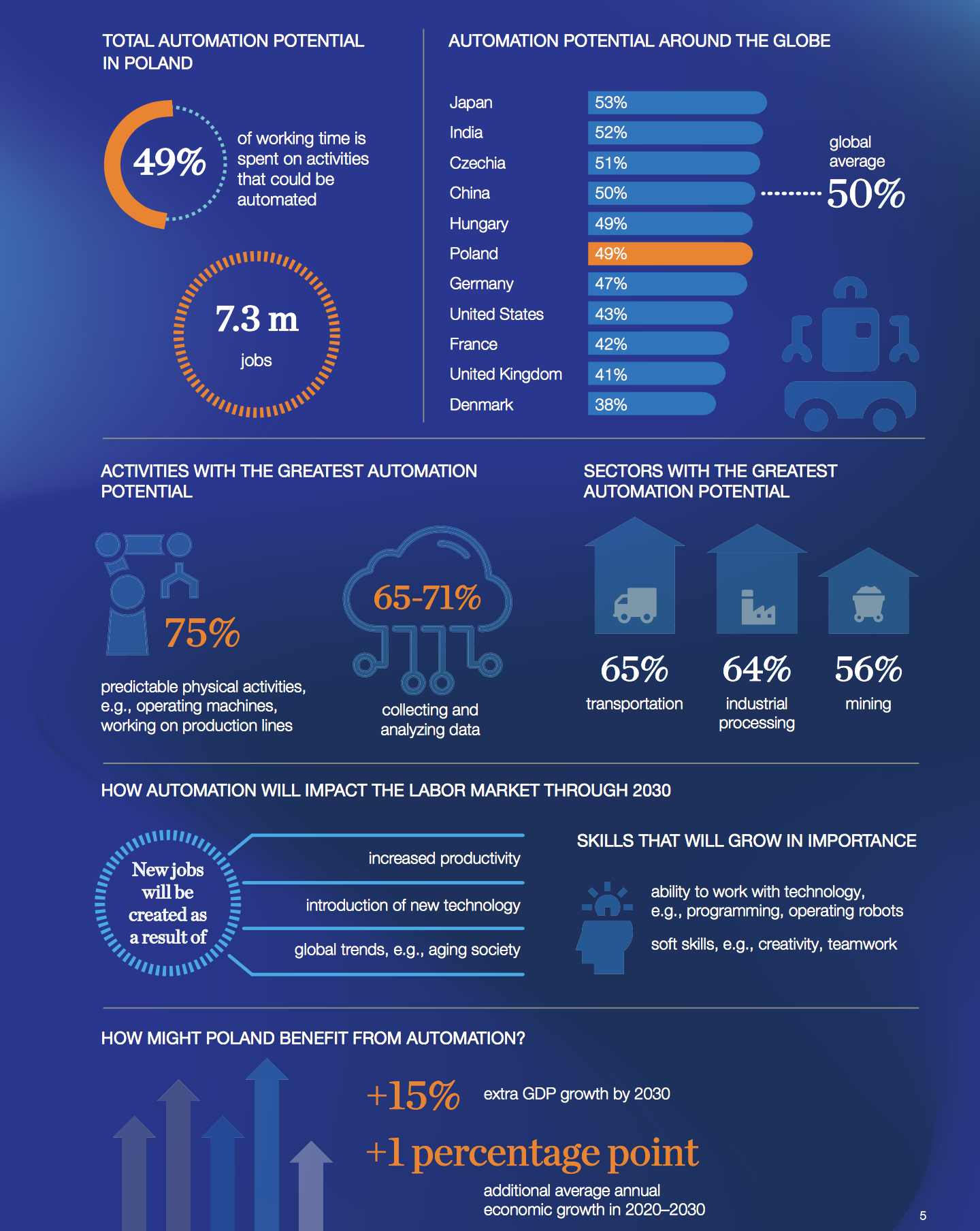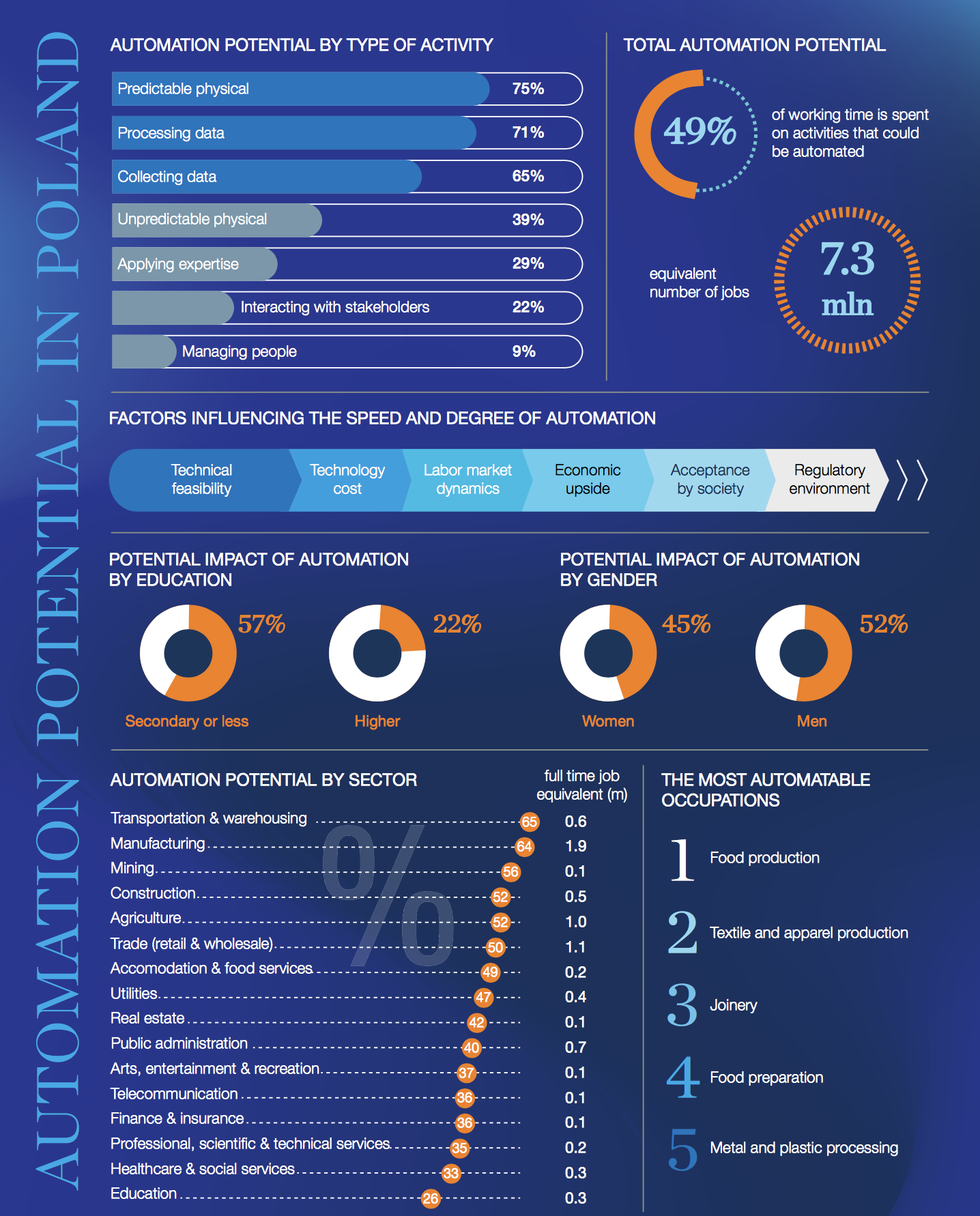“Hand to hand with the robot. How to use the potential of automation in Poland” is the latest report by McKinsey & Company in Poland, prepared in cooperation with the Forbes monthly. We analyze the impact of automation on the Polish economy and the labor market, as well as outline the key challenges and opportunities that it entails. We also present a catalog of activities that can prepare Poles for changes in the labor market. How to use the potential of automation in Poland?
Key conclusions:
- 15 % Polish GDP growth in 2030 thanks to automation and the resulting increase in productivity
- Average annual economic growth by 1 %in 2020-2030 may increase due to automation
- 49 % of labour force (equivalent to 7.3 million jobs) can be automated till 2030
Key insights:
- We stand on the brink of a revolution: the Fourth Industrial Revolution, driven by automation and robotics. The new technology it brings with it will transform the labor market as we know it today.
- According to our estimates, automation and the resulting increase in productivity could push up Poland’s GDP by an extra 15% by 2030, while average annual economic growth in the period 2020-2030 could be more than one percentage point higher than without the impact of automation.
- Our analysis shows that up to 49% of workplace activities today in Poland – the equivalent of 7.3 mil- lion jobs – could potentially be automated by 2030 using technology that already exists today. However, the percentage of activities that will actually be automated will likely be lower due to technological, economic, legislative, and social barriers.
- The figure for automation potential in Poland – 49% – is not far off the global average of 50%, and close to that of other developed countries. According to analysis by the McKinsey Global Institute, automation potential is 53% for Japan, 51% for the Czechia 49% for Hungary, 43% for the United States, and 38% for Denmark.
- The jobs most suitable for automation are typically those based around predictable activities, both physical (such as packaging, welding, loading, preparing meals) and mental (data collection and analysis, filling out forms, generating invoices, updating and processing data). These jobs are performed more often by employees with a lower level of education, and statistically more often by men than women.
- Automation may actually lead to the creation of many new jobs. In the first place, new technology increases productivity, enabling companies to lower their prices, raise salaries, and increase profits. This stimulates demand, which leads to jobs being created. Second, the technologies of automation themselves create jobs – such as those of data analysts, to create and refine the necessary automation algorithms. Third, new jobs will appear as global trends take hold. Analysis by the McKinsey Global Institute (MGI) identifies a number of dominant global trends: an increase in personal income; the development of services for seniors, especially medical support; technological advance and implementation; greater investment in real estate; greater investment in infrastructure; and greater investment in energy.
- In tomorrow’s labor market, the key competencies will be soft skills such as creativity, teamwork, empathy, critical thinking, problem-solving, and the use of technical knowledge with the help of technology. These are skills that can be used in many different professions, not just one industry. Today, employees’ feeling of security comes from having a particular job; in the future, that feeling of security will come from having skills that are in demand in the labor market.
- The main challenge of automation facing Poland is how to effectively combine two markets: on the one hand, the market of people looking for jobs, often experienced in traditional sectors such as industrial processing, transportation and logistics, or agriculture, with secondary education or less and limited skills working with modern technology; and on the other, the market of jobs looking for people – new jobs, in both new and traditional sectors, that require specialist skills and the ability to work with technology.
- To exploit the full potential of automation in Poland, policymakers can already start helping employees adjust to the requirements of tomorrow’s labor market, strategically guiding the process of automation and robotics, and preparing a safety net for individuals and businesses during the changes.
- Businesses in Poland can benefit from the opportunities brought by automation. They could first focus on the new technology powered by automation – not just implementing it but adapting their business processes and organizational structures accordingly. Second, they could invest in human capital as the basis for creating value and competitive advantage. The key will be to analyze the changes required to the structure of qualifications and employment, anticipate which skills the company will need in the future, and develop training programs that enable employees to adapt to the changing conditions.


Link to the full report
Related articles:
– When will we cease be biological people
– Artificial intelligence is a new electricity
– Will a basic income guarantee be necessary when machines take our jobs?
– A machine will not hug you … but it may listen and offer advice
– Can machines tell right from wrong?










TomK
That is why politician should talk about fundamental change of education system not about … taxing robots. The problem is not robotization but that after 16 Y of hard work at school our kids will have to compete with robots as they learn there only what machine can easly do after 2 weeks of being programmed !
PiotrPawlow
Pity for local market only
CaffD
Interesting read. I think that similar insights are applicable in other economies as well
John Accural
Do you have a similar report or other EU countries? Would be great if you could share this on UK, Germany, France
Norbert Biedrzycki
Have a look at McKinsey Global Institute – see country specific sections
Tom299
Neural networks are a subset of machine learning techniques. Essentially, they are AI systems based on simulating connected “neural units,” loosely modeling the way that neurons interact in the brain. As computer processing power has increased we see that large training data sets have been used to successfully analyze input data such as images, video, and speech. AI practitioners refer to these techniques as “deep learning,” since neural networks have many (“deep”) layers of simulated interconnected neurons.
ZoraBora
Power of McKinsey minds
John McLean
Interesting report. Great insights
Karel Doomm2
Congrats. Good stuff
Norbert Biedrzycki
Thank you